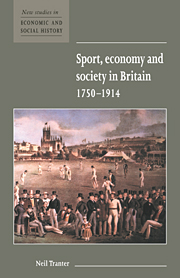3 - The ‘revolution’ in sport
Published online by Cambridge University Press: 18 December 2009
Summary
Whatever happened in the decades immediately preceding the Victorian era, there is no doubt that the period between the mid-nineteenth century and the outbreak of the First World War was characterised by a notable transformation in the scale and nature of Britain's sporting culture. Recently, it is true, sport historians have tended to diminish the sharpness of the contrast previously drawn between the sporting worlds of the early nineteenth and early twentieth centuries. Subsumed within the Victorian and Edwardian sporting ‘revolution’ were numerous elements of continuity from an earlier age; their existence goes far towards explaining why modern versions of traditional sports like folk football and prize-fighting were able to spread so rapidly (Holt, 1988: 70–2; 1989: 57–73; Shipley, 1989: 90; Sandiford, 1994: 19).
Playing and watching sport was common to all social classes in the eighteenth century and, as shown in chapter 1, remained so throughout the first half of the nineteenth century. The number of people involved in sport certainly increased in the course of the second half of the nineteenth and early twentieth centuries; but as late as Edwardian times sport spectating, and particularly playing, was still the minority interest it had always been. On the eve of the First World War no more than one in twenty of all males aged 15–39 actively participated in soccer. Liverpool, with a population of over half a million, had just 224 cricket clubs in 1890 and 212 soccer clubs in 1912: Birmingham, with around 400,000 inhabitants, just 214 cricket clubs in 1880 (Vamplew, 1988a: 12).
- Type
- Chapter
- Information
- Sport, Economy and Society in Britain 1750–1914 , pp. 13 - 31Publisher: Cambridge University PressPrint publication year: 1998
- 1
- Cited by

